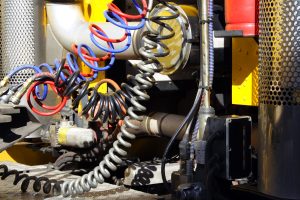A Peek into the World of Semi-Trucks: Air Brakes – the Pulse of Heavy Hauling
 In the vast panorama of heavy-duty vehicle technology, a system of cardinal importance often sits unseen and unsung: semi-truck air brakes. Fundamental to the gargantuan semi-trucks we often see dominating our highways, air brake systems are ingenious feats of engineering, ensuring safety in a world of heavy loads and high speeds.
In the vast panorama of heavy-duty vehicle technology, a system of cardinal importance often sits unseen and unsung: semi-truck air brakes. Fundamental to the gargantuan semi-trucks we often see dominating our highways, air brake systems are ingenious feats of engineering, ensuring safety in a world of heavy loads and high speeds.
Air brakes, unlike their hydraulic counterparts used in smaller vehicles, leverage the power of compressed air. The reason? Air can be easily produced and replaced, and it’s a safer option in case of leaks — a crucial factor when it comes to handling multi-ton vehicles.
The air brake system comprises several key components: an air compressor, reservoirs, service brakes, parking brakes, and brake controls. The air compressor, driven by the engine, generates compressed air, which is stored in reservoirs. When a driver steps on the brake pedal, this air is directed into the brake chambers, pushing the brake shoes against the brake drum and thereby slowing the vehicle.
But there’s another critical aspect: emergency brakes. In the event of a catastrophic air pressure loss, a spring-loaded mechanism in the system instantly applies the brakes. A semi-truck with failed brakes is a frightening prospect, and it’s precisely this danger that this mechanism seeks to mitigate.
The simplicity of the design and the efficiency of the mechanism makes semi-truck air brakes a triumph of engineering. While their maintenance requires a specialized understanding, their performance justifies the effort, ensuring a safe journey for our hardworking truck drivers.
Even as semi-trucks continue to evolve with advanced technologies, air brakes remain the reliable, pulsating heart of their safety system. As crucial as they are invisible, they do the hard work that keeps our highways safer and our goods moving.
The power of “Jake Brakes”: harnessing engine compression for safe trucking
When traversing the highways and byways of North America, one might occasionally hear a thunderous rumble. This resonating sound often originates from a semi-truck and is caused by a useful safety feature: the Jake Brake.
Invented by Clessie Cummins, the Jake Brake, or Jacobs Brake, is an engine braking mechanism installed in many large diesel-powered vehicles. Its purpose? To assist the regular braking system, mitigating brake wear and ensuring safe and controlled deceleration.
The Jake Brake works on the principle of engine compression. In essence, it transforms the truck’s engine into a compression release brake. When engaged, the brake opens exhaust valves in the cylinders after the compression stroke, releasing the compressed air trapped in the cylinder. This action turns the engine’s power against itself, thus slowing the truck down.
This potent deceleration tool is a godsend for truckers driving on steep downgrades or when carrying heavy loads. But the unmistakable roar associated with its use is not music to everyone’s ears. For this reason, some residential areas have forbidden its use.
Ultimately, the Jake Brake is an impressive example of innovative engineering, leveraging engine power for safe and effective braking. While its song might be loud, it’s a melody of safety and control, a tune every trucker appreciates.
Reliable isn’t perfect: truck accidents related to brakes
Air brakes and Jake Brakes may be modern engineering marvels, but that does not mean they are perfect – or that they cannot fail. They can and do. And when they do, it is usually related to:
- Poor maintenance. Heavy duty trucks need maintenance and repairs like any vehicle does. Parts wear and need to be replaced. Hoses can come loose. Moisture can build up in the system, and if the air dryers fail the entire brake system can malfunction. Trucking companies are responsible for maintaining their fleet, taking dangerous trucks off the road, and handling any necessary replacements and repairs.
- Inexperienced drivers. Air brakes work on a slight delay, compared to hydraulic brakes. And unlike hydraulic systems, air brakes “do not automatically release…. They remain deployed until the system starts to recharge.” (Recharging begins once the driver releases the brake, but it takes a moment.) Getting used to the system can take some time, especially for inexperienced drivers who just obtained their CDL. Trucking companies are responsible for ensuring they hire competent drivers, and for any training their employees require.
- Negligence. Some 18-wheeler wrecks have nothing to do with the condition of the brakes, and everything to do with a driver’s failure to use them in time. Speeding, drunk driving, drowsy driving, and distracted driving can all lead to an accident – remember, air brakes take an extra second to engage, and that extra second can be the difference between avoiding and causing a crash. And Jake Brakes, though they work instantaneously, can cause a truck to jackknife if they’re applied at the wrong time or on slick roads.
- Defects in design or manufacturing. Tesla is facing a recall on the Semi, its electric big-rig, because its parking brake valve has a defect. Last year, Daimler recalled more than 218,000 Freightline and Western Star semis because of a brake defect. Volvo issued a recall in 2017 because of defective air dryers. When a truck’s brakes or braking system fails as a result of manufacturing or design defect, the manufacturer itself can be held liable if the failure causes a crash.
How our truck accident attorneys in Phoenix can help after a wreck
When a truck’s brakes fail – because of a defect, negligence, maintenance, or driver inexperience – and that failure results in a crash leading to injuries, Plattner Verderame Arizona Injury Lawyers can help. We understand that accidents with 18-wheelers often lead to catastrophic injuries for drivers and passengers in smaller vehicles, though truck drivers can sustain injuries, too.
The first thing we do is sit down and talk with you about what happened. We’ll review any accident reports as well as your medical records, so we can get a better idea of the true extent of your injuries. If negligence played a role, we can use the truck’s “black box” and recording data to show how fast the driver was going and whether or not he/she hit the brakes. We’ll review cell phone data to see if the driver was distracted, and request access to any breath or blood test results that could indicate the driver was under the influence. We’ll also look at the driver’s history to see if he or she has been cited for negligence or reckless behavior before, or if there is anything in his or her background that should have prevented the company from hiring that driver in the first place.
If the crash was caused by a defective product, then the scope of our investigation may change a bit. In such a case, we would look to both the trucking company and the manufacturer to see what went wrong, and whether there was any known risk. How we handle your case will depend on the exact circumstances, so it’s better to call us as soon as possible so we can get started. Memories fade over time, and some evidence (like tire tracks) may disappear quickly.
If you or a loved one sustained injuries in a truck accident in Arizona, know that you’re not alone. Plattner Verderame Arizona Injury Lawyers has provided thoughtful counsel and experienced representation for decades. We have offices in Phoenix and Tempe, and offer phone and video consultations for clients throughout the state. Please call or contact us today to get started.

Attorney Richard Plattner has been active in leadership in the Arizona Association for Justice (lawyers who represent injured folks, and formerly known as the Arizona Trial Lawyers Association) since 1985 and served as President in 1991. If you have been the victim of a personal injury, contact Plattner Verderame today.
Read more about Richard Plattner.
